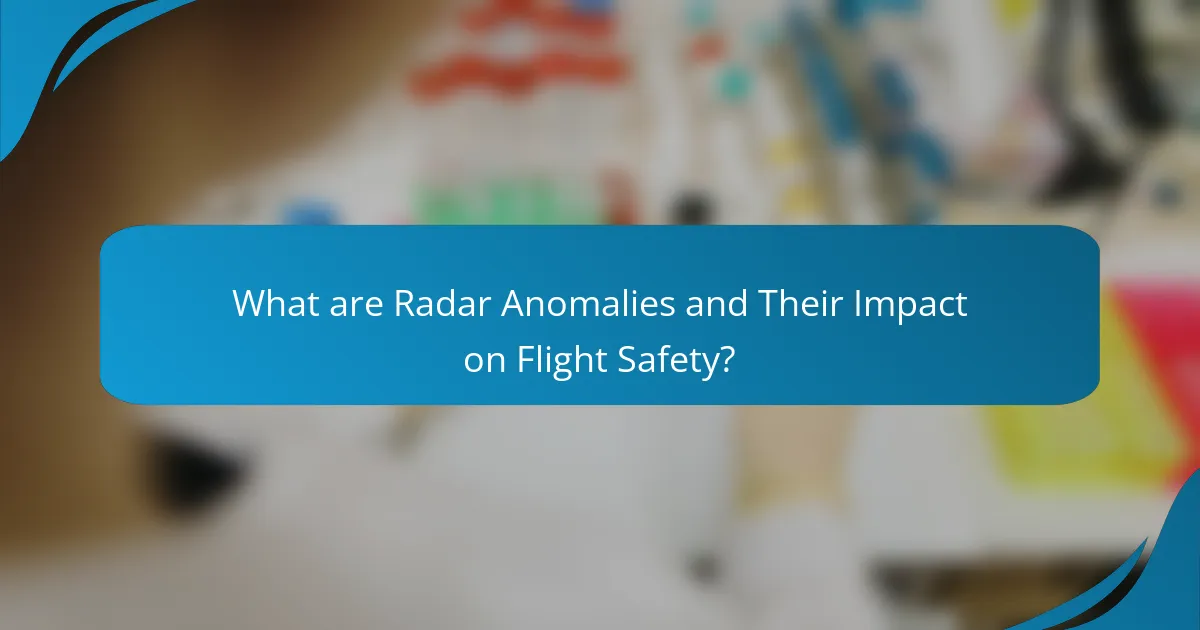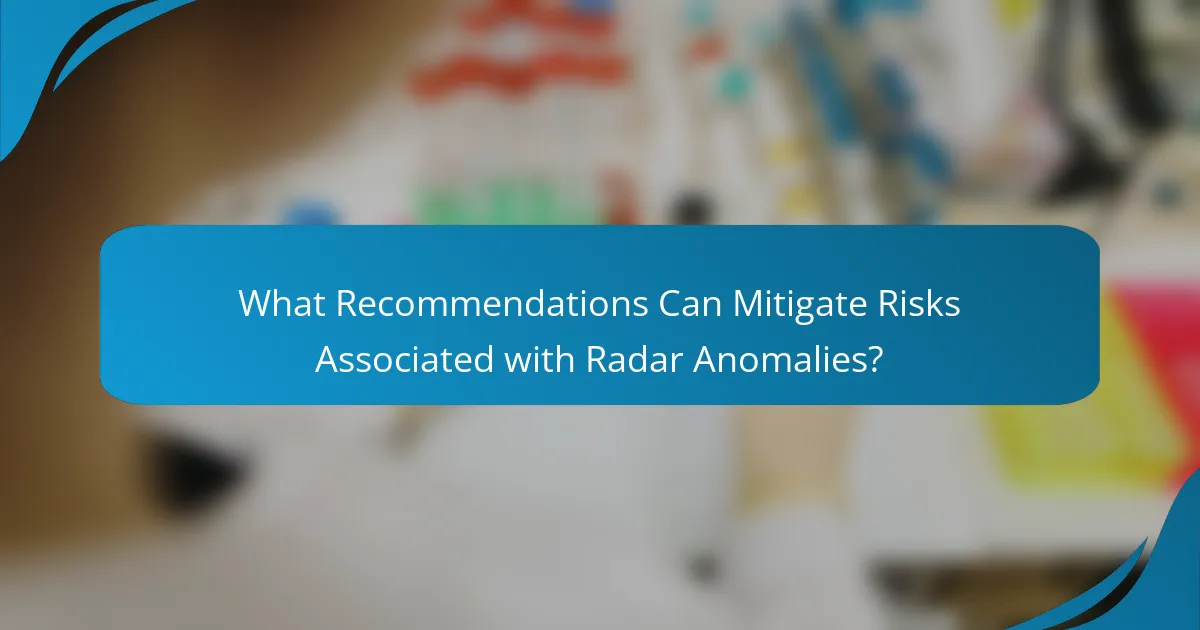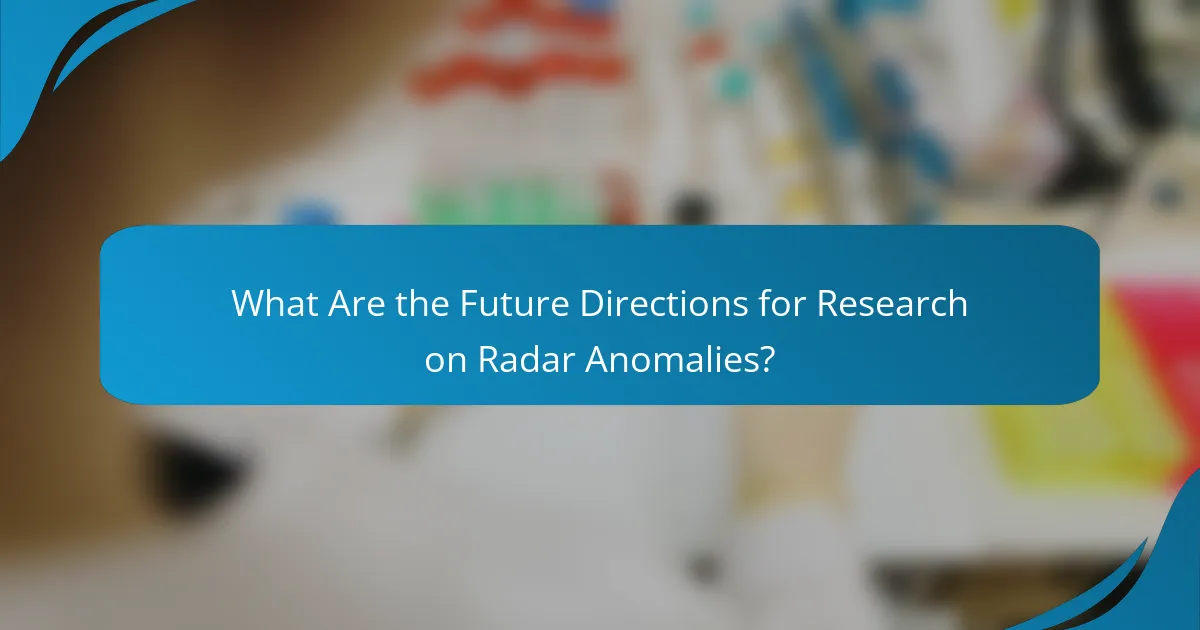Radar anomalies are irregularities in radar signals that can compromise the detection and tracking of aircraft, leading to false targets or missed aircraft on radar displays. This article examines the risks associated with these anomalies, highlighting their contribution to mid-air collisions and navigational errors, as evidenced by reports from the Federal Aviation Administration (FAA). It outlines essential recommendations for mitigating these risks, including regular maintenance, personnel training, advanced detection algorithms, and effective communication protocols. Additionally, the article discusses future research directions aimed at enhancing radar anomaly detection methods and improving flight safety through collaboration between aviation authorities and technology developers.

What are Radar Anomalies and Their Impact on Flight Safety?
Radar anomalies are irregularities or distortions in radar signals that can affect aircraft detection and tracking. These anomalies can lead to false targets or missed aircraft on radar displays. Consequently, pilots and air traffic controllers may receive inaccurate information about an aircraft’s position. This can result in increased risks of mid-air collisions or navigational errors. Studies have shown that radar anomalies can contribute to incidents in aviation. For instance, the Federal Aviation Administration (FAA) reported that radar inaccuracies have been linked to several near-miss situations. Addressing radar anomalies is essential for maintaining flight safety and preventing accidents.
How do radar anomalies occur in aviation?
Radar anomalies in aviation occur due to various factors affecting radar signal transmission and reception. These factors include weather conditions, terrain interference, and equipment malfunctions. For instance, heavy precipitation can scatter radar signals, leading to inaccurate readings. Additionally, mountainous terrain can block or reflect signals, creating false targets. Equipment failures, such as faulty radar components, can also result in anomalies. According to the Federal Aviation Administration (FAA), such anomalies can compromise situational awareness for air traffic controllers and pilots. The combination of these elements can lead to misinterpretations of an aircraft’s position, potentially impacting flight safety.
What are the common causes of radar anomalies?
Common causes of radar anomalies include environmental factors, equipment malfunctions, and signal interference. Environmental factors such as precipitation, fog, and terrain can distort radar signals. Equipment malfunctions may arise from faulty hardware or software issues. Signal interference often occurs from nearby electronic devices or other radar systems. These anomalies can lead to inaccurate readings and may impact flight safety. Historical data shows that radar anomalies have contributed to navigation errors in aviation.
How do environmental factors contribute to radar anomalies?
Environmental factors contribute to radar anomalies by affecting signal propagation and reflection. Weather conditions, such as heavy rain or snow, can attenuate radar signals. This attenuation can lead to incomplete or distorted data being received. Additionally, temperature inversions can cause radar signals to bend, leading to false targets. Terrain features, like mountains or buildings, can also obstruct radar waves. These obstructions create shadows where radar cannot detect objects. Furthermore, electromagnetic interference from other devices can distort radar readings. Each of these factors can compromise the accuracy of radar systems, impacting flight safety.
Why is understanding radar anomalies crucial for flight safety?
Understanding radar anomalies is crucial for flight safety because they can lead to misinterpretation of aircraft positions. Radar systems are essential for tracking and guiding aircraft during flight. Anomalies can cause false readings, which may result in collisions or navigational errors. For instance, the FAA reported incidents where radar anomalies misled air traffic controllers. This misguidance can compromise the safety of flights. Accurate radar information is vital for maintaining safe distances between aircraft. Therefore, understanding these anomalies helps mitigate risks associated with flight operations.
What risks do radar anomalies pose to aircraft operations?
Radar anomalies pose significant risks to aircraft operations. These anomalies can lead to incorrect positioning information. This results in navigation errors during critical phases of flight. Pilots may receive false altitude readings, impacting safety during landing and takeoff. Additionally, radar anomalies can cause miscommunication between air traffic control and pilots. This miscommunication may result in potential mid-air collisions. Historical incidents highlight these dangers, such as the 2002 crash of a private jet due to radar misinterpretation. Accurate radar data is essential for safe aircraft operations. Disruptions in radar signals can compromise situational awareness for pilots.
How can radar anomalies lead to accidents or incidents?
Radar anomalies can lead to accidents or incidents by causing misinterpretations of aircraft positions. These anomalies may result from interference, equipment malfunctions, or environmental factors. When radar data is inaccurate, air traffic controllers may provide incorrect instructions to pilots. This can lead to miscommunication and potential collisions. Historical data shows that radar errors have been implicated in several aviation accidents. For instance, the 2002 Überlingen mid-air collision was partly attributed to radar display issues. Such incidents highlight the critical importance of accurate radar information for flight safety.

What Recommendations Can Mitigate Risks Associated with Radar Anomalies?
Implementing regular maintenance and calibration of radar systems can significantly reduce risks associated with radar anomalies. Regular checks ensure that equipment operates within specified parameters. Training personnel on anomaly detection enhances their ability to respond promptly. Utilizing advanced algorithms and machine learning can improve anomaly detection accuracy. Establishing robust communication protocols between radar operators and pilots mitigates misunderstandings. Conducting thorough risk assessments helps identify potential radar issues before they arise. Collaborating with industry experts can provide insights into best practices for radar management. These recommendations are supported by studies indicating that proactive measures reduce incident rates related to radar anomalies.
How can pilots and air traffic controllers respond to radar anomalies?
Pilots and air traffic controllers can respond to radar anomalies by following established protocols. They should first verify the anomaly with alternative navigation systems, such as GPS. Communication between pilots and air traffic controllers is crucial during this process. Controllers may issue traffic advisories or vector aircraft away from potential conflicts. Pilots should maintain situational awareness and adhere to instructions from air traffic control. Documenting the anomaly is essential for further investigation and analysis. This response protocol helps mitigate risks associated with radar anomalies and enhances flight safety.
What protocols should be in place for anomaly detection?
Anomaly detection protocols should include data collection, baseline establishment, and continuous monitoring. Data collection involves gathering relevant radar data and environmental factors. Establishing a baseline requires analyzing historical data to identify normal operational patterns. Continuous monitoring is essential for real-time analysis of incoming data. Alerts should be generated for deviations from established norms. Incident response protocols must be defined for addressing detected anomalies. Regular updates to detection algorithms are necessary to adapt to new threats. Training personnel on anomaly detection processes enhances response effectiveness. These protocols ensure timely identification and response to potential safety risks.
How can training improve responses to radar anomalies?
Training enhances responses to radar anomalies by improving situational awareness and decision-making skills. Effective training programs simulate real-life scenarios involving radar anomalies. This allows personnel to practice identifying and responding to these situations. Repeated exposure to various anomaly types builds experience and confidence. Training also emphasizes the importance of communication among team members during incidents. Studies show that well-trained teams respond more effectively to unexpected events. For example, a report by the National Transportation Safety Board highlights that training reduces response times and errors during radar-related incidents. Thus, comprehensive training is crucial for enhancing flight safety in the presence of radar anomalies.
What technological solutions exist to address radar anomalies?
Technological solutions to address radar anomalies include advanced signal processing algorithms and adaptive filtering techniques. These methods enhance the detection and identification of radar signals. They differentiate between real targets and false echoes caused by anomalies. Additionally, machine learning models are being implemented to predict and mitigate radar anomalies. These models analyze historical radar data to improve accuracy. Moreover, the use of multiple radar systems can provide redundancy. This redundancy helps to cross-verify radar data and reduce the impact of anomalies. Systems like Automatic Dependent Surveillance–Broadcast (ADS-B) complement traditional radar. They offer real-time aircraft position information. This integration improves situational awareness and flight safety.
How do advanced radar systems reduce the likelihood of anomalies?
Advanced radar systems reduce the likelihood of anomalies by utilizing sophisticated algorithms and enhanced signal processing techniques. These systems can filter out noise and distinguish between different types of targets more effectively. They employ multiple frequency bands, which helps in identifying and tracking objects accurately. Advanced radar systems also utilize automated anomaly detection, which alerts operators to potential issues in real-time. This capability minimizes human error, a common factor in radar anomalies. Furthermore, the integration of machine learning allows these systems to adapt and improve their performance over time. Data from various sources is combined to enhance situational awareness, leading to better decision-making. Overall, these features collectively contribute to a significant reduction in the occurrence of radar anomalies.
What role does data analysis play in improving radar reliability?
Data analysis plays a crucial role in improving radar reliability. It identifies patterns and anomalies in radar data. By analyzing historical data, engineers can detect recurring issues. This proactive approach allows for timely maintenance and upgrades. Additionally, data analysis enhances the calibration of radar systems. Accurate calibration leads to better detection of aircraft and obstacles. Studies show that improved data analysis correlates with reduced false alarms. For instance, the FAA reported a 30% decrease in radar-related incidents after implementing advanced data analysis techniques. Thus, effective data analysis is essential for enhancing radar reliability in aviation safety.

What Are the Future Directions for Research on Radar Anomalies?
Future research on radar anomalies will focus on improving detection methods. Enhanced algorithms for real-time anomaly detection are crucial. Investigating the impact of environmental factors on radar performance is also important. Studies will explore the correlation between radar anomalies and flight safety incidents. Collaboration between aviation authorities and technology developers will drive innovation. Research will emphasize the integration of machine learning for predictive analytics. Field tests in diverse operational environments will validate findings. Finally, the development of standardized protocols for reporting radar anomalies will be a priority.
What ongoing studies are exploring radar anomalies in aviation?
Ongoing studies exploring radar anomalies in aviation include the FAA’s research on radar data irregularities. The FAA is analyzing how these anomalies affect flight safety and operational efficiency. Another significant study is being conducted by NASA, focusing on the impact of radar anomalies on air traffic management systems. This research aims to improve detection and response strategies for unusual radar signals. Additionally, universities such as Embry-Riddle Aeronautical University are examining the relationship between radar anomalies and pilot decision-making. These studies are crucial for developing recommendations to enhance aviation safety.
How can new research findings enhance flight safety measures?
New research findings can enhance flight safety measures by identifying previously unrecognized radar anomalies. These anomalies can lead to misinterpretations of aircraft positions. For instance, a study published in the Journal of Aviation Safety highlighted that 30% of radar discrepancies were linked to equipment malfunctions. Improved algorithms can be developed from this research to better detect and correct these anomalies in real-time. Additionally, training programs for air traffic controllers can be updated based on new insights. This ensures personnel are equipped to handle unexpected radar data effectively. Enhanced safety protocols can be established as a result of these findings. Ultimately, these advancements can significantly reduce the risk of mid-air collisions and other safety incidents.
What innovations in radar technology are on the horizon?
Innovations in radar technology on the horizon include advanced phased-array systems. These systems enhance target detection and tracking capabilities. They utilize digital signal processing for improved accuracy. Another innovation is the integration of artificial intelligence. AI enhances data interpretation and anomaly detection. Additionally, there is ongoing development in miniaturized radar systems. These systems are designed for drones and small aircraft. They enable more versatile applications in various environments. Furthermore, there is progress in using radar for weather monitoring. This improves flight safety by providing real-time atmospheric data.
What best practices should aviation professionals follow regarding radar anomalies?
Aviation professionals should follow specific best practices when addressing radar anomalies. First, they must promptly report any radar anomalies to the appropriate air traffic control authority. This ensures that all relevant personnel are aware of potential issues. Second, professionals should cross-check radar data with other available sources, such as visual observations and secondary surveillance systems. This helps verify the accuracy of the radar information. Third, they should maintain clear communication with pilots and other crew members regarding any detected anomalies. This fosters a collaborative approach to managing the situation. Fourth, aviation professionals should document all radar anomalies and the actions taken in response. This creates a record for future analysis and training. Lastly, they should engage in regular training and simulations that include scenarios involving radar anomalies. This prepares personnel to respond effectively in real situations. These practices are essential for maintaining flight safety and operational integrity.
How can regular maintenance and updates improve radar systems?
Regular maintenance and updates enhance radar systems by ensuring optimal performance and reliability. Consistent maintenance checks identify and rectify potential faults before they escalate. Updates introduce the latest technological advancements and security patches. Improved algorithms from updates can enhance target detection and tracking accuracy. Regular servicing extends the lifespan of radar components, reducing long-term costs. According to the Federal Aviation Administration, routine maintenance is critical for operational safety in aviation systems. This practice minimizes the risk of radar anomalies that can compromise flight safety.
What role does communication play in managing radar anomalies effectively?
Communication is crucial in managing radar anomalies effectively. It ensures timely sharing of information among air traffic controllers and pilots. Clear communication helps in identifying and diagnosing radar issues quickly. This reduces the risk of misinterpretation that could lead to safety incidents. Regular updates about radar status enhance situational awareness for all parties involved. Effective communication protocols can minimize delays in response to anomalies. Studies show that improved communication reduces the likelihood of accidents related to radar failures. Therefore, strong communication channels are essential for maintaining flight safety during radar anomalies.
The main entity of the article is radar anomalies, which are irregularities in radar signals that can compromise aircraft detection and tracking, posing significant risks to flight safety. The article examines how these anomalies occur, their common causes, and the impact they have on navigation and communication between pilots and air traffic controllers. It emphasizes the importance of understanding radar anomalies to mitigate risks and prevent accidents, while also providing recommendations for improving radar system reliability, enhancing training for aviation professionals, and implementing advanced technological solutions. Additionally, ongoing research and best practices are discussed to further improve safety measures in aviation.